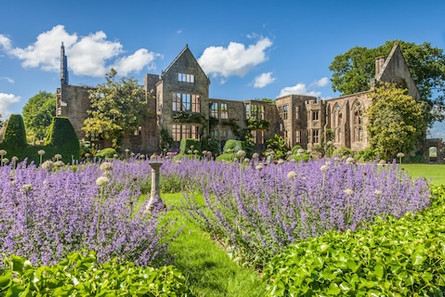Nymans - Enchanting Havens
- Lilium

- Jul 28, 2021
- 6 min read

Nymans is an English garden to the east of the village of Handcross, and in the civil parish of Slaugham in West Sussex, England. The garden was developed, starting in the late 19th century, by three generations of the Messel family, and was brought to renown by Leonard Messel.
Colonel Leonard Messel succeeded to the property in 1915 and replaced the nondescript Regency house with the picturesque stone manor, designed by Sir Walter Tapper and Norman Evill in a mellow late Gothic/Tudor style. He and his wife Maud (daughter of Edward Linley Sambourne) extended the garden to the north and subscribed to seed collecting expeditions in the Himalayas and South America.
The garden reached a peak in the 1930s and was regularly opened to the public. The severe reduction of staff in World War II was followed in 1947 by a disastrous fire in the house, which survives as a garden ruin. The house was partially rebuilt and became the home of Leonard Messel's daughter Anne Messel and her second husband the 6th Earl of Rosse. At Leonard Messel's death in 1953 it was bequeathed to the National Trust with 275 acres of woodland, one of the first gardens taken on by the Trust.

I had traveled down to Surrey, an area of England I had not explored before, staying for a long weekend for my birthday. I chose to go to Surrey for the sheer number of gardens it possessed and which were all placed so close together. I had my work cut out to narrow down which of the gardens to visit and upon seeing the ruined gothic windows amongst the flowers at Nymans, there was no question as to my choice.
The sun was blazing as my companion and I arrived at the gardens, walking past a second hand bookshop I knew I would return to later. Clipped hedges towered above and around us, obscuring our view as we followed the path, trusting that it led somewhere. And led somewhere it did. We approached a gap in a circle of hedge, and the scent reached us before any sight. We had reached the Rose Garden.

The roses were set out in beds like a maze, each one different in colour and size, great arbours overwhelmed with blooms crossed over the paths. A fountain trickled at the centre of the garden, in the beds around it were exquisite roses, some in a colour as though they had been soaked in tea but they smelt like apricots, others in a vivid pinks were fragranced with spiced Turkish Delight. At the centre of the these beds were great pyramid arbours draped with honeysuckle intertwined with clematis. Each person who entered gasped as their senses were overtaken by the beauty of the roses. There were so many heady scents that one began to feel dizzy if one lingered too long. And while it was hard to pull away from this heaven we had just stumbled into, there was much more waiting beyond its fragrant walls.
Following the path, we were led though a woodland garden, an orange bricked wall could be glimpsed beyond the trees. After a left we came to a fork in the road, left towards the Lime Walk and Arboretum but we take the path on the right that follows along the wall in search of a door. We are quickly rewarded by a great brick arch topped with an elaborate scene of marble cupids. We have reached Nymans famous Walled Gardens.

Thick borders overflowing with flowers lined the path, even though they shone with colour they had yet to reach their peak but this took nothing away from their beauty. A lone gardener with a wheelbarrow full of pots was filling the gaps of the borders, a sign informs us that they plant 6,500 annuals in the summer borders, so he had a long job ahead. A fountain sat at the centre of this garden too but this fountain was surrounded by clipped topiary.
Beyond the fountain a great tree could be seen that from a distance, looked like it was blanketed in snow. It was a Kousa Dogwood, its flowers were at their peak. While from a distance it looked like one mass of white, it was in fact individual flowers with four white petals with a green button at their centre. After staring for some time at the magical illusion of snow on a summers day we moved on through the summer borders until we reached some steps, and for the first time, had a clear view of the house.
Through another brick arch we went, but this one was more medieval, small with an old oak door. It led to the Forecourt Garden, thick beds of daisies, lavender and verbena led to the dovecote tower in the wall on one side and on the other side the house joined the ruins with a carpet of Erigeron at its feet. A manicured lawn was cut into four by stone paths with four mushroom shaped topiaries at their centres. A plant I had not seen before climbed the walls of the gothic ruin, it was a Mexican hydrangea. It scampered up the walls, leaving yellow-white flowers in its wake.
Through another arch we came to a courtyard made of hedges, clipped into turrets. On the one wall that joined the ruin a great wisteria climbed the wall, it stems now as thick as tree branches showed its age. In the middle of the courtyard were low hedges trained and cut into diamonds with cosmos at their centres. To the left an ornate white bench sat stark against the dark green turrets behind, its design spelt out the initials A.R. (Anne Russel.)
Through a black iron gate the gardens opened out and we stood in front of the ruin, its great windows draped in climbing white roses on both wings. The sight was so overly romantic it almost seemed like it couldn't be real. Here amongst the roses and wisteria was the entrance to the house. We entered with great anticipation.
Now I must be honest with your dear reader, that despite my chosen career as a historian I am surprisingly forgetful. And despite having known the name of Nymans before I chose to visit for its gardens, I had completely forgotten that it was because it was the ancestral home of Oliver Messel. So I am sure you can imagine my surprise to walk into the living room to find a picture of him campily posed on the piano. For a moment I was in doubt and as I turned to look into the room to confirm my suspicions, there was Oliver's portrait of Nathalie Paley casually hanging on the wall. Forgetfulness is a terrible trait to have when your line of work depends on remembering things.
The rooms were cosy and quiet with carefully chosen antiques. Red velvet curtains framed the lattice windows, great tapestries hung on the walls, carved furniture was dotted about, as was artwork by Oliver Messel. His drawings of house plans for the Caribbean and other portraits sit quietly in the dark of a corridor. Through an old oak door frame was a cosy library, the gilt of the book titles glinted in the dim light and an old television made to look like a theatre was tucked in a corner. Then all of a sudden we were outside again. Which was not a problem, as out across the lawn there were more gardens to discover.

Round the side of the ruins was the Prospect, with unspoilt views out across the valley. Through hedge mazes and rock gardens, along the wisteria covered pergola and we found ourselves back at the walled garden.

We took our time and walked back to the second hand bookshop where I picked up 'Leaves from the Garden', two centuries of garden writing, the back cover read 'An indispensable companion for all gardeners.' Now I might have been dubious of this claim if the book did not contain writings by Beverley Nichols and Vita Sackville-West.
Then we came to the dangerous part of Nymans. The plant shop. Here they had plants from the gardens themselves and I spent an awful lot of money on lots of lovely things like royal blue salivas and rosea lavender and a pen knife that I really didn't need but somehow made it into the mix. What I had not considered was how I was going to get this box full of plants back 154 miles home. They all made it home and were planted amongst the sweet peas and the roses. I have no regrets. I can't say the same thing for my wallet however.

Below is a short film I made from the videos I took at Nymans (apologies again for the portrait mode.)
Reading Recommendations & Content Considerations
Shirley Nicholson Clare Best & Caroline Boisset







































































































































































































































































Comments